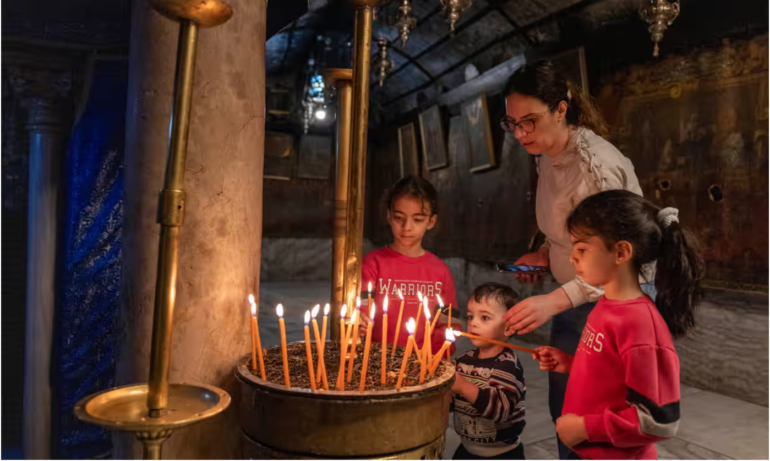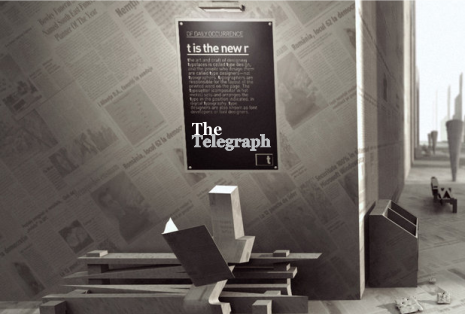Usually full of tourists, Manger Square is now sad and empty, and a nativity baby Jesus lies nearby in rubble.
At Bethlehem’s Lutheran Evangelical church, the nativity scene looks very different this Christmas. Instead of a cot in a hay-filled manger, the baby doll has been wrapped in the famous black and white keffiyeh associated with Palestine, and lies among broken breeze blocks and paving slabs.
Christmas celebrations have been cancelled across the Holy Land this year as the region mourns the Palestinians – now more than 20,000, according to Hamas – killed in the Gaza Strip. Munther Isaac, the pastor of the Lutheran church, said he wanted to send the world a message with this year’s nativity scene. “This is the reality of Christmas for Palestinian children,” he said. “If Jesus was born today, he’d be born under the rubble of Gaza.”
Bethlehem, 10 miles south of Jerusalem in the occupied West Bank, is one of the most important centres of Christianity; the Church of the Nativity, today shared by several sects, was built by Emperor Justinian 1,500 years ago above the grotto where it is believed Christ was born.

Today, the majority of Bethlehem’s population is Muslim but the town is still home to a thriving Christian community and many Christian orders, and the area relies heavily on the tourism and pilgrimage sector. Around 70% of the Bethlehem economy depends on international visitors, said the mayor, Hana Haniyeh.
“This period is usually very active. We get 1.5 – 2 million visitors a year, but now we have zero,” he said. “Israel has made it very difficult to get here through the checkpoints and our economy has crashed, but we could not celebrate anyway. We are in mourning for the people of Gaza.”
Since the occupied Palestinian territories do not have an airport, most international visitors enter through Israel, crossing checkpoints in its West Bank barrier wall that keeps the two holy cities of Jerusalem and Bethlehem separate from one another, despite the fact that they’re only six miles (10km) apart.
Manger Square in the heart of Bethlehem, outside the Church of the Nativity, is usually thronged with tourists in December. There are festive lights, a giant Christmas tree, and the town’s alleyways and restaurants are filled with music. This year though, Manger Square is grey and empty. No one the Observer spoke to in Bethlehem on Friday could recall a time that there was no traditional tree. Outside the Bethlehem Peace Center, a banner said in Arabic and English: “Stop the genocide, stop the displacement, lift the blockade”.
The busy December programme includes hosting international delegations and performances from artists and singers before the festivities culminate with a parade and midnight mass on Christmas Eve. But attendance is expected to be so low this year that the Franciscan order that assigns tickets and deals with security for the event has scrapped the usual protocols; instead, the prayer service will be open to anyone who can make it.
Weathering the pandemic was a challenge, but last year Bethlehem’s 5,000 hotel rooms were once again fully booked over Christmas, and were set to do good business again in 2023 before the war broke out.
“I would get 50 tour groups a month in my shop. All the hotels were reserved again this year and we expected it to be great but that dream was shattered because of the conflict. Everyone cancelled,” said Nabil Giacaman, a third-generation woodworker, and owner of the Il Bambino arts and sculpture shop. His was the only shop open on Friday; he said he had come by just to keep himself busy.
“I have 12 employees but I don’t think I can pay them at the end of the month,” he said. “We desperately need the tourists.”
Millions of pilgrims usually visit every year, but very few Christians live in the Holy Land. A century ago, they made up a quarter of Jerusalem’s population but now represent less than 2%. The community struggles to afford housing, and the West Bank security wall has isolated them from their brethren in Jerusalem.
Today there are just 182,000 Christians in Israel, 50,000 in the West Bank and Jerusalem, and 1,300 in Gaza, according to US state department estimates. When the Islamist group Hamas seized control of the strip in 2007, 3,000 Christians were registered as living there. In the besieged territory, the already tiny Christian community has been decimated by the new war, sparked by the 7 October attack on Israel by Hamas that killed 1,140 people.
The Catholic Holy Family church in Gaza City has become a makeshift shelter but has been repeatedly hit by Israeli airstrikes. Last week, the Latin Patriarchate in Jerusalem said the Israel Defense Forces (IDF) had placed the church under siege, and snipers shot and killed two Christian women, a mother and daughter, who had ventured outside for food and water. Pope Francis condemned the attack, which the IDF denied knowledge of.

The Liberal Democrat MP for Oxford West and Abingdon, Layla Moran, has said she worries that her family members and the other 300 people trapped at the church will not survive until Christmas.
In Jerusalem, too, Christmas festivities were cancelled by heads of the major churches. The ancient passageways of the Old City, normally full of tourists and pilgrims throughout the year, have been quiet since October. Most shops and restaurants are closed, with business owners saying they are too scared to come to work.
Israeli settlers in the Old City – like the rest of East Jerusalem, annexed by Israel in 1980 – have used the chaos of the war to their advantage. There have been attempts by Israeli developers to seize land in the Armenian quarter that belongs to both the church and individual Armenian Christians; members of the 800-strong community are now camping out 24 hours a day on sites they believe are under threat.
Both the Muslim and Christian presence in the Old City and its surroundings were steadily being eroded anyway, owing to efforts by settlers as well as the Israeli government. Over the last few years, the state has accelerated its campaign to demolish increasing numbers of Palestinian homes on the grounds they lack building permits, and displace the community with development projects.
Christian leaders in Israel and Palestine have been refraining from entering politics or current affairs, but the outpouring of grief and condemnation of the war from the patriarchates this year shows the depth of the anger many of the churches feel.
“We are sad at seeing all the victims, especially women and children, and we are sad that the international community hasn’t taken serious action to end the massacre, as they did when Russia invaded Ukraine,” said Father Rami Askarieh, the parish priest of Bethlehem’s St Catherine’s church.
“We pray each day for Gaza and for the victims of the war on both sides,” he said. “Israelis, Palestinians; we are all human, we are all the children of God.”


